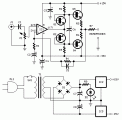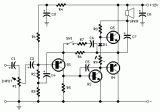FREE
circuits!
Audio amplifier circuit diagrams
December 13, 2010
The circuit is a microphone amplifier for use with low impedance (~200 ohm) microphones. It will work with stabilized voltages between 6-30VDC. If you don't build the impedance adapter part with T1, you get a... [more]
December 13, 2010
This is a very simple, low cost, Hi-Fi quality power amplifier. You can build it 5 ways, like it’s shown in the table (from 20 W to 80 W RMS). [more]
December 2, 2010
A small 325mW amplifier with a voltage gain of 200 that can be used as a bench amplifier, signal tracer or used to amplify the output from personal radios, etc. [more]
November 26, 2010
After buying the processor, monitor, and printer, I wasn't willing to spring for a set of speakers too. After going "soundless", I decided to add speakers. Of course, this was the perfect excuse warm up... [more]
November 15, 2010
Can be directly connected to CD players, tuners and tape recorders. Tested with several headphone models of different impedance: 32, 100, 245, 300, 600 & 2000 Ohms. Schematic shows left channel only. [more]
November 10, 2010
This circuit, connected with 32 Ohms impedance mini-earphones, can detect very remote sounds. Useful for theatre, cinema and lecture goers: every word will be clearly heard. [more]
November 9, 2010
The circuit is simple, yet is capable of excellent performance. I designed it specifically for use as an amplifier for the digital sound card in my computer. Audio input can be from any two-channel line... [more]
November 8, 2010
The aim of this design is to reproduce a Combo amplifier of the type very common in the sixties and the seventies of the past century. [more]
October 13, 2010
This amplifier was designed to be self-contained in a small loudspeaker box. It can be feed by Walkman, Mini-Disc and CD players, computers and similar devices having line or headphone output. Of course, in most... [more]










 This category
This category